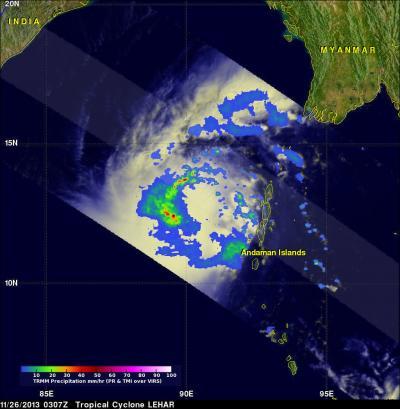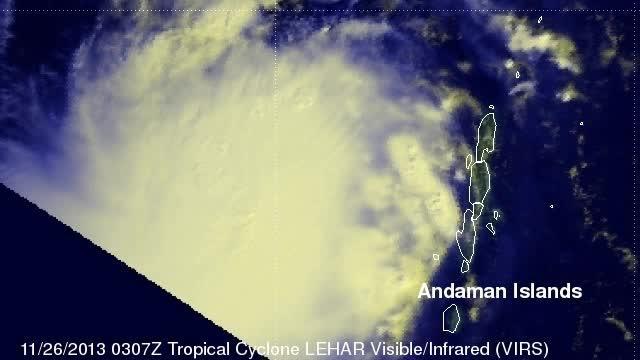Tropical cyclone Lehar, located in the Bay of Bengal, continues to gain intensity while heading toward the same area of India where a much weaker tropical cyclone Helen recently came ashore. NASA's TRMM satellite passed over Lehar and measured rainfall and cloud heights to give scientists an understanding of how the storm is behaving.
NASA's Tropical Rainfall Measuring Mission satellite called TRMM flew above tropical cyclone Lehar on November 26, 2013 at 0307 UTC/Nov. 25 at 10:07 p.m. EST and captured rainfall data. Rainfall rates occurring in the storm were derived from TRMM's Microwave Imager (TMI) and Precipitation Radar (PR) instruments. That data was taken and overlaid on an enhanced visible/infrared image from TRMM's Visible and InfraRed Scanner (VIRS) at NASA's Goddard Space Flight Center in Greenbelt, Md. to create a total picture of rainfall within the tropical cyclone. The TRMM instruments found that rain was falling at a rate greater than 64 mm/~2.5 inches per hour in Lehar's center and in a band of intense rain wrapping around Lehar's northwestern side. Some strong thunderstorms within Lehar were reaching heights above 15.25 km/~9.5 miles.
Warnings are already in effect in India. Northern Andhra Pradesh and southern Odisha are expected to feel Lehar's effects on Wednesday, November 27, when winds are expected to reach up to 91.7 knots/105.6 mph/170 kph.
At 1500 UTC/10 a.m. EST on November 26, Tropical Cyclone Lehar's maximum sustained winds were near 75 knots/86.1 mph/138.9 kph. Tropical-storm-force winds extend up to 100 nautical miles/115.1 miles/185.2 km from the center of the storm or 200 miles/230.2 miles/370.5 km in diameter. Lehar's center was located about 471 nautical miles southeast of Visakhapatnam, India, near 12.9 north and 88.6 east. Lehar was moving to the west-northwest at 9 knots/10.3 mph/16.6 km.
The Joint Typhoon Warning Center or JTWC predicts that Lehar's sustained wind speeds will reach 95 knots/~109 mph on November 27, 2013 and then decrease to about 85 knots/~98 mph before hitting India's east-central coast.

On Nov. 26, 2013. NASA's TRMM satellite saw that rain was falling at a rate greater than 64 mm/~2.5 inches per hour in Lehar's center and in a band of intense rain wrapping around Lehar's northwestern side.
(Photo Credit: Image : NASA/SSAI, Hal Pierce)

This animation from Nov. 26, 2013 shows the blending of rain over clouds using NASA's TRMM satellite TMI/PR and VIRS instruments. Rain was falling at a rate greater than 64 mm/~2.5 inches per hour in Lehar's center and in a band of intense rain wrapping around Lehar's northwestern side.
(Photo Credit: Image : SSAI/NASA, Hal Pierce)
Source: NASA/Goddard Space Flight Center